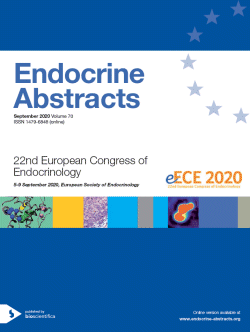
22nd European Congress of Endocrinology
Online
05 Sep 2020 - 09 Sep 2020
Oral Communications
Young Investigators
ea0070yi1 | Young Investigators | ECE2020
A mixed nutrient preload attenuates glucose-induced endothelial dysfunction in individuals with abnormal glucose tolerance
Trico Domenico , Nesti Lorenzo , Mengozzi Alessandro , Baldi Simona , Natali Andrea
ea0070yi2 | Young Investigators | ECE2020
Transcriptomic response of mouse thyroid to iodine by upregulating Nrf2-dependent and independent pathways
Chartoumpekis Dionysios , Ziros Panos , Habeos Ioannis , Kyriazopoulou Venetsana , Smith Adam , Marques Ana Claudia , Sykiotis Gerasimos
ea0070yi3 | Young Investigators | ECE2020
RNA-sequencing of adrenocortical tumors reveals novel pathogenetic insights
Di Dalmazi Guido , Altieri Barbara , Scholz Claus , Sbiera Silviu , Luconi Michaela , Waldmann Jens , Kastelan Darko , Ceccato Filippo , Chiodini Iacopo , Arnaldi Giorgio , Osswald Andrea , Reincke Martin , Beuschlein Felix , Sauer Sascha , Fassnacht Martin , Appenzeller Silke , Ronchi Cristina
ea0070yi4 | Young Investigators | ECE2020
Evidence for increased SSTR5 expression and improved pasireotide response in USP8 mutant corticotroph tumours
Albani Adriana , Perez-Rivas Luis Gustavo , Sicheng Tang , Buchfelder Michael , Rotermund Roman , Flitsch Jörg , Losa Marco , Stalla Günter , Reincke Martin , Theodoropoulou Marily
ea0070yi5 | Young Investigators | ECE2020
Splicing machinery is dysregulated in craniopharyngiomas: a novel source of diagnostic, prognostic and therapeutic biomarkers
Fuentes-Fayos Antonio C , Sanchez-Medianero Teresa , Cano David A , Martínez-Ortega Antonio J , Toledano-Delgado Álvaro , Dios Elena , Venegas-Moreno Eva , Cárdenas Eugenio , Martínez-Barbera Juan P , Castaño Justo P , Soto-Moreno Alfonso , Ortega Salas Rosa M , Luque Raúl M
ea0070yi6 | Young Investigators | ECE2020
Dysregulation of splicing factor 3B SUBUNIT 1 (SF3B1) is associated with the pathological transformation of the liver: Pharmacological inhibition with pladienolide-B as novel therapeutic tool in liver disease
Jiménez Vacas1 Juan Manuel , López-Cánovas Juan L , Del Rio-Moreno Mercedes , García-Fernandez Helena , Sánchez-Frias Marina E , Amado Victor , L-López Fernando , Fondevila Marcos F , Ciria Ruben , Briceño Javier , Nogueiras Rubén , De la Mata Manuel , Castaño Justo P , Rodriguez-Perálvarez Manuel , Luque Raúl M , Gahete Manuel D
ea0070yi7 | Young Investigators | ECE2020
Congenital isolated follicle-stimulating hormone deficiency due to the FSHB gene mutation in a female patient – a rare case report
Paczkowska Katarzyna , Kolanowska Monika , Wikiera Beata , Bolanowski Marek , Jażdżewski Krystian , Daroszewski Jacek
ea0070yi8 | Young Investigators | ECE2020
Towards the development of an in vitro 3D human thyroid model
Vural Özlem , Daher Ugarit , Kadler Shirin , Mogl Martina , Goretzki Peter , Lauster Roland
ea0070yi9 | Young Investigators | ECE2020
Comparison between the efficacy of the Anti-BAFF monoclonal antibody belimumab vs methylprednisolone in active moderate-severe graves’ orbitopathy: an interim analysis
lazzaroni Elisa , Covelli Danila , Currò Nicola , Campi Irene , Vannucchi Guia , Dazzi Davide , Muller Ilaria , Guastella Claudio , Dolci Alessia , Arosio Maura , Salvi Mario
ea0070yi10 | Young Investigators | ECE2020
Association of dietary and plasma fatty acids with adipose triglyceride lipase (ATGL) and hormone-sensitive lipase (HSL) gene expression in human adipose tissues
Yuzbashian Emad , Asghari Golaleh , Zarkesh Maryam , mirmiran Parvin , Hedayati Mehdi , Khalaj Alireza
ea0070yi11 | Young Investigators | ECE2020
Growth hormone-releasing hormone (GHRH) antagonists increase the sensitivity to radiotherapy in lung cancer cells
Gesmundo Iacopo , Dematteis Alessandro , Fanciulli Alessandro , Romana Giglioli Francesca , Cai Renzhi , Sha Wei , Ricardi Umberto , Ghigo Ezio , Schally Andrew V , Granata Riccarda
ea0070yi12 | Young Investigators | ECE2020
Identification of transcriptome profiles in paraffin samples using 3’ RNA-sequencing for the prognostic assessment of adrenocortical carcinoma
Jouinot Anne , Sibony Mathilde , Jeanpierre Lindsay , Septier Amandine , De Murat Daniel , Armignacco Roberta , Perlemoine Karine , Izac Brigitte , Letourneur Franck , Ragazzon Bruno , Leroy Karen , Gaujoux Sebastien , Dousset Bertrand , Groussin Lionel , Libe Rossella , Bertherat Jerome , Assié Guillaume



